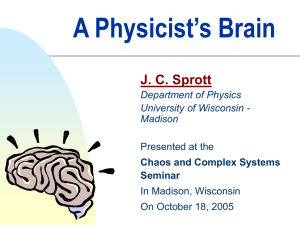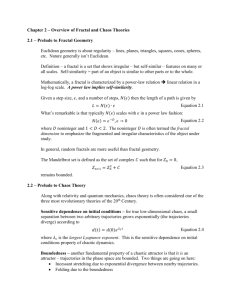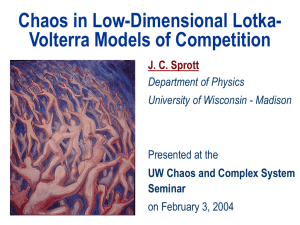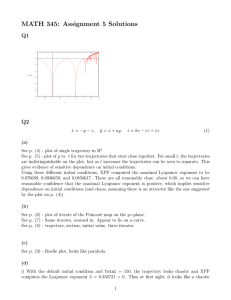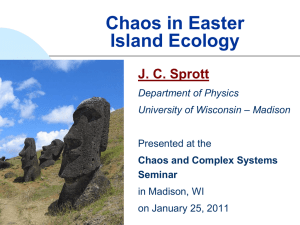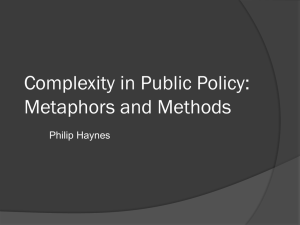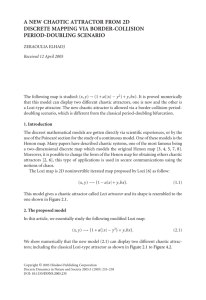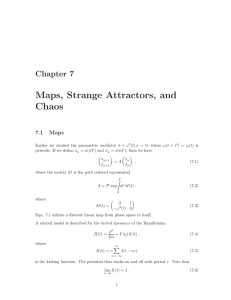Talks_and_Reviews_files/Contolling Chaos11
advertisement
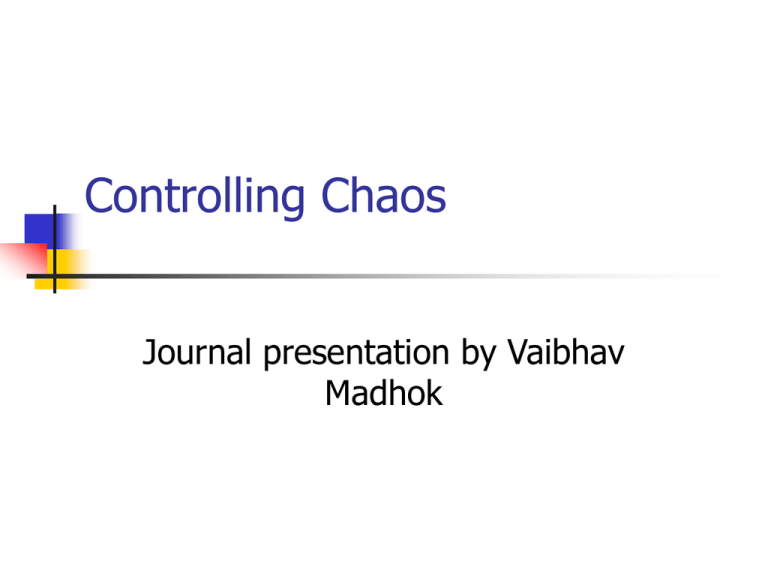
Controlling Chaos Journal presentation by Vaibhav Madhok Outlook Background of chaos OGY Method to Control chaos Experiment to Control chaos Modification made by DN Chaos Control by self-controlling feedback Conclusion References Chaos Defining chaos, Essential features of trajectories, Phase space picture, Geometry, Strange attractors, Topology, Fractals. Chaos Chaos is aperiodic long-term behavior in a deterministic system that exhibits sensitive dependence on initial conditions. Obeys deterministic laws of evolution Long-term aperiodic behavior Sensitive dependence or the “butterfly effect” The Butterfly effect Exponential divergence of nearby trajectories t ~ 0 e t The plot There are ‘n’ Liapunov exponents for an n dimensional system. Example A game of pinballs 2 1 3 Analytical model Differential equations Necessary condition for chaos is nonlinearity. Not a sufficient condition. Example: Damped and driven pendulum: x y, y cy sin x F cos z, z t c 0.05, 0.7, The phase space approach x y, y cy sin x F cos z, z t c 0.05, 0.7, The system is periodic for F values:0.4,0.5, 0.9 but chaotic for 0.6,0.7 and 1.0 Geometry of the attractor Chaotic trajectories typically are confined to a bounded region, yet they separate from their neighbors exponentially fast. What is happening? Geometry of the attractor Process of stretching and folding…. The pastry map. The cross section is a cantor set! Geometry of the attractor 1) 2) 3) An attractor is a closed set such that Any trajectory that starts on A, remains on A. A attracts an open set of initial conditions A is minimal: No proper subset of A satisfies A and B. Few attractors Lorenz Attractor dx/dt = sigma (y-x) dy/dt = rho x - y - xz dz/dt = xy - beta z Rossler Attractor dx/dt = - (y+z) dy/dt = x + a y dz/dt = b + z(x-c) Geometry of the attractor Geometry of the attractor is typically associated with fractals… 1) Fractals have fine structure at arbitrary scales. 2) Dimension can be a non integer. Koch Curve The cantor set Branches Divergence of nearby trajectories on the Lorenz attractor. Small set of initial conditions Evolution and diverging of trajectories. Final state shows sensitive dependence on initial Essence of OGY Method Butterfly effect revisited……. Balancing a stick on your Palm In principle, small perturbations can be given to any system wide parameter of the system. Poincare sections Poincare surface of the section technique Fixed point Periodic orbit in the map as repeated iteration Poincare section Theoretical analysis of the OGY method Z f (Z , p ), Z f (Z , p ), Z Z A(Z Z ) B( p p ), ( p p ) K (Z Z ) Z ( A BK ) Z . n 1 n * * n 1 * n 0 n * n T n n 0 * T n 1 n 0 Analysis g Z / * p 1 p Z (p ) * Z n 1 Assume the fixed point initially to be the origin. pg n [ u eu f u s es f ][ Z s n p g] n Equations for control The condition to be on the stable manifold next iteration: f .Z u p ( n u 0 n 1 1 1 ) (Z n . u (1) f u ) / g. The parameter p has a threshhold, above which we cannot work. f u (2) Time to achieve control The control is activated if Zn falls in a narrow strip: Z u n Z* Where , Z Z u n s n f .Z f .Z u n , s n , Hence , Z * p (1 u ) g . 1 * f Time to achieve control: p * u Numerical example Considering a Henon map: xn1 A xn B y , 2 n y n 1 x, n B 0.3, AA 0 p p is the control parameter. Verification of the power law : Two important issues Delayed coordinate embedding How to find fixed points? Application on a magnetoelastic ribbon Delay coordinate embedding x ( y x), y rx y xz, z bz xy . 10,r 28,b 8 / 3 Time series of measuring variable x(t) with t=0.05 time steps. Reconstruction of the Lorenz attractor v i ( xi , xi l ,..... xi ( m 1)l ). Here: l=3 and m=3. How to obtain fixed points? Observe 2 successive points close to each other in the time series. Z n 1 ZF M( X n2 n 1 X n 1 X n 1 Z n1 X n X F Z F X F Z Z Z n F ), Experiment…controlling the magneto-elastic ribbon Young’s Modulus of the ribbon is changed by applying H(t). Finding fixed points and linearization 1) Linearize the time series data to find M, hence the eigenvalues and eigenvectors n 1 M ( ), F n F X n2 n 1 X n 1 n1 X n1 Xn F X F X F 2) Change Hdc and find the precise location of fixed point and find vector g : g Z * / p 1 p Z (p ) * Experiment Time series for Xn for Hdc=0.112Oe, Hac=2.050 Oe, and f=.85Hz Switching between different periods Modification made by DN The Basic idea is that if the parameter p is changing, The Poincare map depends on both Pn and Pn-1 result. i 1 P( ,P ,P) i 1 i n1 M n w p n i v p n 1 Optimal value of Pn is given by demanding: f u . p i i 1 0 u f u .u f u . i f u .v . f u .u p i 1 , Modification made by DN Further modification gives: n 2 M n w 2 f u . i2 and p i 1 0. 0 p n 1 (v Mw) p n Mv p n 1 , Modification of the equations The Duffing attractor The Duffing equation: x1 x , 2 x2 dx2 x1 x1 f cos x3 , 3 x3 1 Attractor and cross section for d=0.2, f=36,w=0.661 Application to the Duffing oscillator Delayed self controlling feedback 1) Small time continuous perturbation 2) External force control y P( y, x) F (t ), x Q ( x, y ) F (t ) K [ y (t ) y (t )] KD(t ) i External Force control a) Rossler system dx/dt = - (y+z) dy/dt = x + 0.2 y+F(t) dz/dt = 0.2 + z(x-5.7) k=0.4 b) Lorenz system x ( y x), y rx y xz, z bz xy . 10,r 28,b 8 / 3 Delayed feedback control The control equation F (t ) K[ y(t ) y(t )] KD(t ) Delayed feedback control a) Rossler system dx/dt = - (y+z) dy/dt = x + 0.2 y+F(t) dz/dt = 0.2 + z(x-5.7) K=0.2 t=17.5 Conclusion 1) Chaos can be controlled using small perturbations to the system. 2) System dynamics need not be known. 3) Different periods can be stabilized in the same system in the same parameter range. 4) Noise in the system can again throw it out of control 5) Control can be obtained in the form of feedback. References References Nonlinear Dynamics and Chaos, Steven H. Strogatz Classical Dynamics of particles and systems:Thornton, Marion
